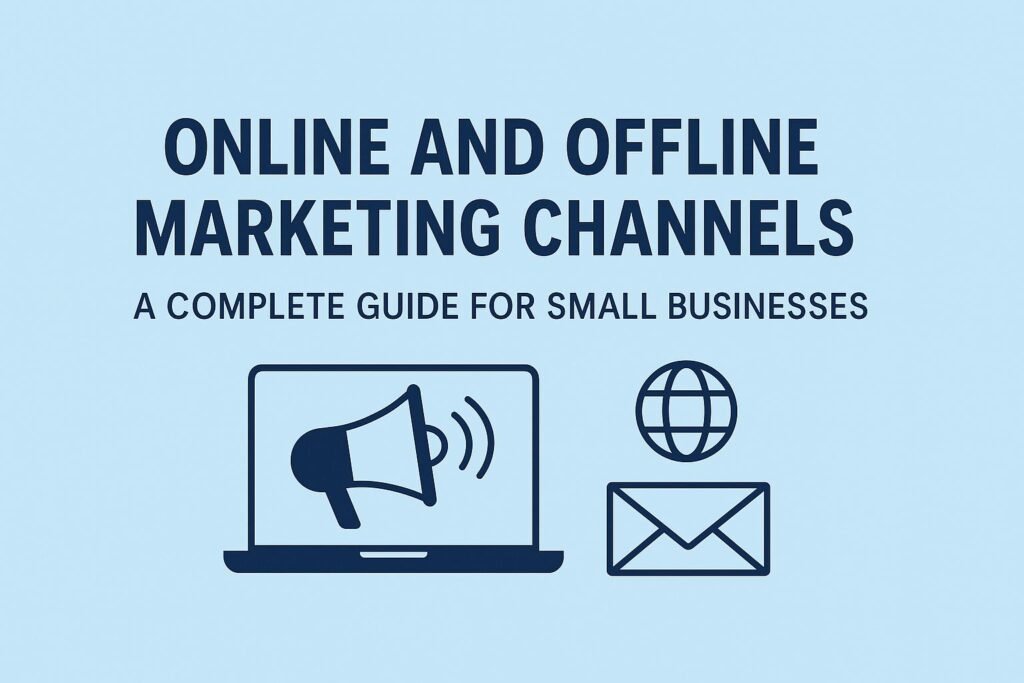
Online and offline marketing channels are essential for small businesses aiming to reach the right audience and build a strong brand. With the rise of online marketing methods like social media marketing, blogging, and content creation, it’s easier than ever to connect with customers. But traditional offline marketing channels—like print ads and local promotions—still play a powerful role, especially for local reach and personal connection.
In this guide, we’ll explore both online and offline marketing channels, how they work, and how combining them can help your business grow faster and smarter.
What Are Online and Offline Marketing Channels?
Online and offline marketing channels refer to the platforms and methods used to promote products or services in either digital or physical spaces.
- Online marketing channels operate through the internet and digital devices. These are fast, trackable, and often more cost-effective.
- Offline marketing channels are traditional forms of promotion that happen in the real world—like print ads, events, and direct mail.
Each has its strengths, and understanding when and how to use them can transform your marketing efforts.
Top Online Marketing Channels for Modern Businesses
. Here are some of the most popular online marketing channels used by businesses today:
1. Social Media Marketing
Platforms like Instagram, Facebook, Pinterest, LinkedIn, and TikTok allow you to connect with your audience, build a brand, and drive traffic. These channels are excellent for both organic growth and paid advertising.
2. Email Marketing
Email remains one of the most powerful online marketing channels. It helps you maintain direct communication with customers, promote offers, share content, and nurture leads.
3. Content Marketing and Blogging
Publishing high-quality, SEO-optimized blog posts can attract organic traffic over time. This very article is an example of how online marketing channels can educate and engage potential customers.
4. Search Engine Marketing (SEM)
Pay-per-click (PPC) ads and display ads on Google or Bing help you target specific audiences and get immediate traffic. These are effective online marketing channels for boosting visibility fast.
5. Influencer Marketing and Affiliate Programs
Collaborating with influencers or affiliates can expand your reach and create trusted recommendations for your products or services.
Top Offline Marketing Channels Still Making an Impact
Here are some of the top offline marketing channels still making an impact today:
1. Print Advertising
Newspaper ads, flyers, brochures, and magazines are classic offline marketing channels that still reach wide audiences. They’re especially useful for promoting local offers and events.
2. Direct Mail
Sending postcards, letters, or catalogs directly to homes creates a personal connection. Direct mail as an offline marketing channel can be highly targeted and memorable.
3. Events and Trade Shows
Face-to-face interactions at community events, expos, or trade shows can build strong relationships and generate leads in a way online methods can’t.
4. Radio and Television Advertising
While these can be expensive, they remain powerful offline marketing channels for reaching mass audiences with brand messaging.
5. Word of Mouth and Referral Marketing
Encouraging happy customers to spread the word is one of the oldest yet most trusted offline marketing channels.
Combining Online and Offline Marketing Channels for Maximum Reach
Using both online and offline marketing channels allows you to cover all the bases. For example:
- A local bakery can use Instagram ads (online) to promote a weekend sale while handing out flyers (offline) at a community market.
- A freelance coach can blog (online) to build authority and speak at local events (offline) to connect with the community.
Blending strategies increases brand recognition and improves the customer experience.
Final Thoughts on Online and Offline Marketing Channels
Choosing between online and offline marketing channels isn’t about one being better than the other — it’s about balance. Your ideal mix depends on your business goals, audience, and budget.
Start with the channels you can manage effectively, then expand. Track your results, test new approaches, and don’t be afraid to blend the old with the new.
By mastering both online and offline marketing channels, you’re setting your business up for long-term growth and visibility. For more ideas, check out Powerful ideas for offline marketing to grow your business.
